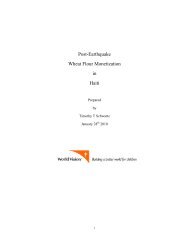Food Consumption Patterns Part 2
You also want an ePaper? Increase the reach of your titles
YUMPU automatically turns print PDFs into web optimized ePapers that Google loves.
89<br />
None of this is to say that only local peanut butter is on the market. In visits to 19 urban<br />
supermarkets, we found that all stocked imported peanut butter brands. But that is as far as<br />
imported peanut butter gets. It is conspicuously absent from the popular market. One can infer that<br />
part of the reason for their absence is the lower cost--as seen, arguably the major determinant of<br />
food consumption in Haiti.<br />
Official Imports have increased dramatically in the past two decades, from 16 metric tons of peanut<br />
butter in 1998 to 104 metric tons in 2008. However, if accurate, this represents less than 1% of<br />
domestic production. At 20 metric tons in 2012, MFK was the only known importer of whole<br />
peanuts (Illustrative of the problem with customs and records is that imported peanuts are<br />
nevertheless present in supermarkets). It is difficult to evaluate what this means because, as seen<br />
in Section 7 above, corruption and poor record keeping at the ports mean that customs data often<br />
says more about politics than actual flows of merchandise.<br />
The participation of popular micro-entrepreneurs and the highly integrated informal market<br />
system—vs. a clumsy and poorly developed formal sector—are surely key factors that help explain<br />
the low cost of domestic peanut products. Family labor is involved in production, shelling,<br />
packaging, transport and processing. Peanuts are the most commonly transformed food in Haiti,<br />
so one finds mills even in urban neighborhoods, and one would be hard pressed to find an adult<br />
woman who has not, at some time in her life, processed and sold peanut butter. Moreover, the<br />
actual creation of the peanut butter is only the second step in the value chain. The entire chain<br />
can—as seen in Figure 34 above-- touch as many as eight market actors: grower, 1 st purchaser,<br />
sheller, transporter to 2 nd market, 2 nd purchaser and processer of peanuts, miller, purchaser of<br />
peanut butter in bulk, retailer vendor of peanut butter and bread or cassava.<br />
Health and Who Consumes Peanuts<br />
Although only 1 respondent in the 50-<br />
respondent ‘most nutritional foods’ survey<br />
mentioned peanuts, 87% of people in the 632<br />
respondent Consumer Survey said peanuts<br />
and peanut butter are good for the health<br />
(Figure 36). Indeed, the importance of<br />
peanuts in the popular class diet cannot be<br />
overstated. Only 26 of the 632 respondents<br />
in Consumer Survey (4%) said they do not<br />
eat peanuts (Figure 35); fully 96% said they<br />
eat peanuts or peanut butter, 54% of these<br />
eating them at least once per day, and 30%<br />
eating them more than once per day (Figure<br />
37). v<br />
Consumers Opinions, Preferences and Tastes<br />
Photo 50: Peanuts afflicted by the fungus that<br />
producing aflatoxin
















